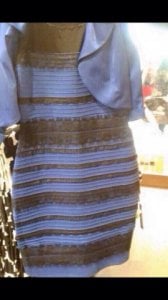- Joined
- Apr 8, 2014
- Messages
- 1,229
This is an interesting concept - how much can we be influenced by the power of suggestion?
If you are on social media you have probably seen the following image:
The debate rages on and on about whether this is a white and gold dress or a blue and black dress.
Everyone MUST be crazy, I thought - it is obviously white and gold.
"no so fast..." I have been told, as several of my friends tell me they see a blue and black dress.
So, I went to the tried and true source of de-bunking internet myths - snopes.com. Here is what they had to say:
So - the answer appears to not really be an answer - is the claim here that the power of suggestion (and software) can cause people to see the blue in a dress where little or none exists?
Interesting point, you may say, but how does this relate to RockyTalky?
I am curious how this same technique or controversy might play-out in the examination of diamonds?
Is it possible that a slight blue tinge to some people is an obviously blue diamond to others? (I think we know this to be the case)
When pictures are sent to consumers, are there potential tricks of the computer monitor, and photographic shadings to influence the color (or non-color) of the diamonds, or do they appear the same in real life?
We are continually in discussion of how light plays in mono vs. stereo vision and how diamond color and dispersion is interpreted - could the power of suggestion be as noticeable in a picture (or real-life) with a diamond as it is in this social media phenomenon?
Just curious to see if anyone else is as intrigued by this as I am.

If you are on social media you have probably seen the following image:
The debate rages on and on about whether this is a white and gold dress or a blue and black dress.
Everyone MUST be crazy, I thought - it is obviously white and gold.
"no so fast..." I have been told, as several of my friends tell me they see a blue and black dress.
So, I went to the tried and true source of de-bunking internet myths - snopes.com. Here is what they had to say:
On 25 February 2015, a striped dress that appeared to be white and gold to some (but blue and black to others) began to circulate on the social blogging network Tumblr. As the popularity of the image increased, the debate intensified. According to an informal poll, roughly a quarter of people believed the dress was blue and black, while three quarters believed it was clearly white and gold:
On 26 February 2015, a Twitter user claimed that the photograph was actually a "sight test" that indicated any given viewer's emotional state. The user did not, however, explain why such a "test" was being administered or what the ultimate purpose (aside from retweets) might be.
While the converse (colors potentially influencing emotions) has been studied and posited, we turned up no evidence that the theory was proposed or tested in the opposite direction. (It is possible that the Twitter user in question misinterpreted the widespread belief colors affect emotions, or that the individual was simply taking advantage of a viral phenomenon.)
Fortunately for the internet, there is actually an answer to this conundrum. The highlighted bit of the darker top stripe read as hex code #806D48 through an eyedropper tool — clearly a gold-based tone. However, a lighter portion of the sleeve (described by many as white) was hex code #A0A1B9, a heavily blue-tinged color. Ultimately, it's far less likely that the image is a mood diagnostic than a mild prank involving image manipulation software and the power of suggestion.
So - the answer appears to not really be an answer - is the claim here that the power of suggestion (and software) can cause people to see the blue in a dress where little or none exists?
Interesting point, you may say, but how does this relate to RockyTalky?
I am curious how this same technique or controversy might play-out in the examination of diamonds?
Is it possible that a slight blue tinge to some people is an obviously blue diamond to others? (I think we know this to be the case)
When pictures are sent to consumers, are there potential tricks of the computer monitor, and photographic shadings to influence the color (or non-color) of the diamonds, or do they appear the same in real life?
We are continually in discussion of how light plays in mono vs. stereo vision and how diamond color and dispersion is interpreted - could the power of suggestion be as noticeable in a picture (or real-life) with a diamond as it is in this social media phenomenon?
Just curious to see if anyone else is as intrigued by this as I am.









300x240.png)